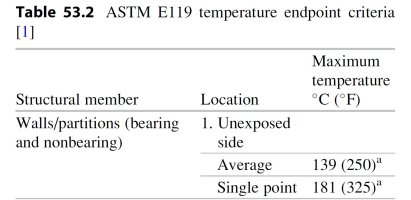Scratching my head with ASTM E119, I couldn't decide which subforum to post, sorry about that.
ASTM E119 test criteria include the temperature increase on the unexposed side of the assembly being tested (wall, slab etc).
Per the year 2000 edition, during the classification period, the average temperature of the unexposed surface must not have been raised more than 250 degrees Fahrenheit (139 degrees Celsius).

The thing is, 250 F is equal to 121.111 C, not 139 C.
There is a difference of 17.8888 C between these two values.
If we assume that 17.8888 C is the ambient temperature, an increase of 250 F would indeed raise the temperature up to 139 C.
The same happens on the single point temperature limits set elsewhere in the ASTM E119 test method documente, 325 degrees Fahrenheit (181 degrees Celsius) while 325 F equals just 162.777 C.
Again , adding the ambient temperature of 17.888 C , the temperature reaches 181 C.
The relevant table in the SFPE Fire Protection Handbook , citing ASTM E119 edition 2006 as its source, has a footnote (a) “Maximum temperature cited refers to the maximum temperature rise above initial conditions”.

It seems however that the footnote applies to the Celsius value alone, not the Fahreneit.
I cannot figure out why.
The thing is, which is correct?
Ambient temperature plus 250 F, or a measured temperature of 250 F?
Does anyone have access to a more recent edition of ASTM E119 with more clear text?
ASTM E119 test criteria include the temperature increase on the unexposed side of the assembly being tested (wall, slab etc).
Per the year 2000 edition, during the classification period, the average temperature of the unexposed surface must not have been raised more than 250 degrees Fahrenheit (139 degrees Celsius).

The thing is, 250 F is equal to 121.111 C, not 139 C.
There is a difference of 17.8888 C between these two values.
If we assume that 17.8888 C is the ambient temperature, an increase of 250 F would indeed raise the temperature up to 139 C.
The same happens on the single point temperature limits set elsewhere in the ASTM E119 test method documente, 325 degrees Fahrenheit (181 degrees Celsius) while 325 F equals just 162.777 C.
Again , adding the ambient temperature of 17.888 C , the temperature reaches 181 C.
The relevant table in the SFPE Fire Protection Handbook , citing ASTM E119 edition 2006 as its source, has a footnote (a) “Maximum temperature cited refers to the maximum temperature rise above initial conditions”.

It seems however that the footnote applies to the Celsius value alone, not the Fahreneit.
I cannot figure out why.
The thing is, which is correct?
Ambient temperature plus 250 F, or a measured temperature of 250 F?
Does anyone have access to a more recent edition of ASTM E119 with more clear text?
